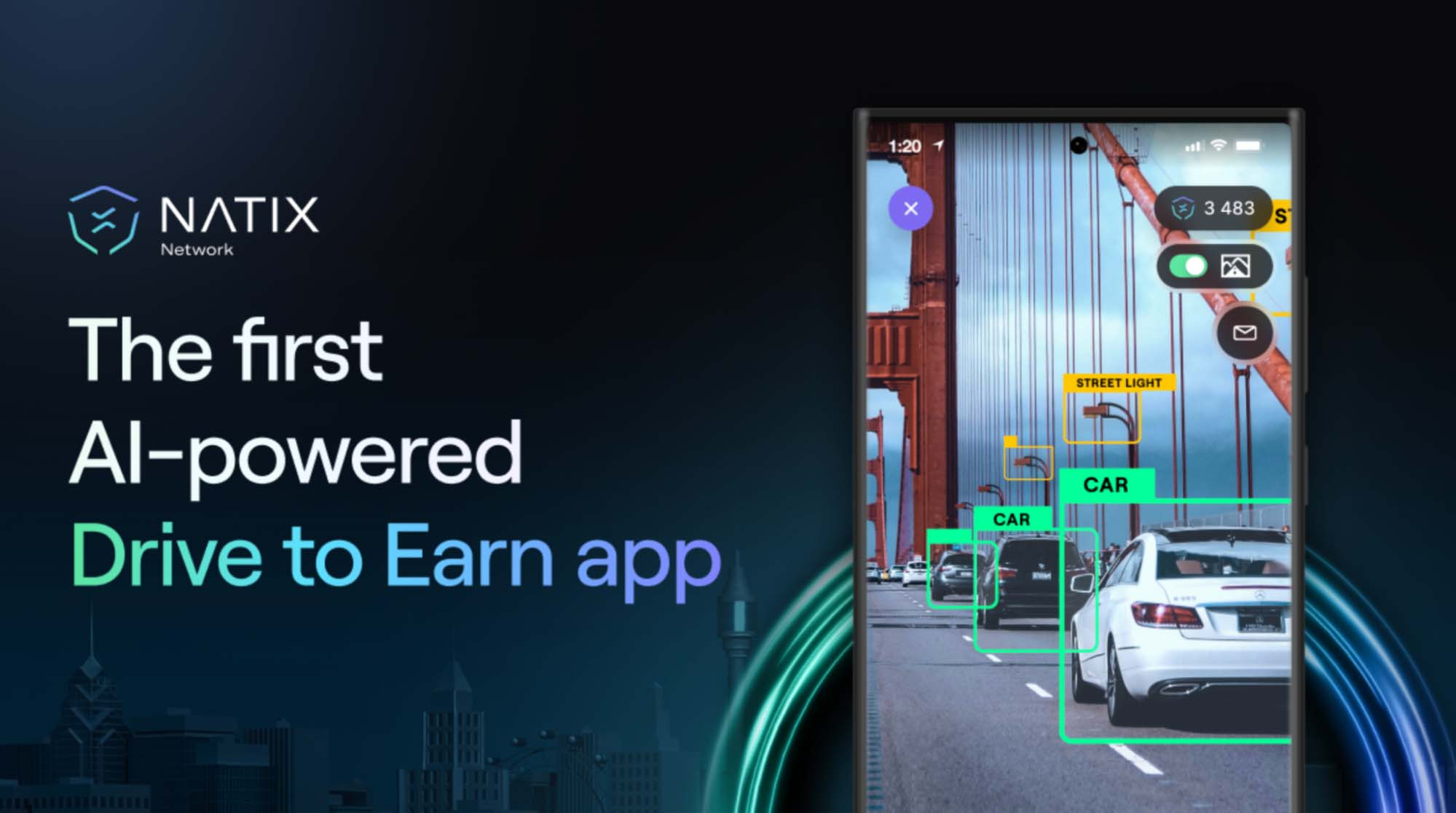Updated on: Feb 12th, 2025. Original title: Redefining Navigation Through AI-Powered Decentralization
We first covered NATIX networks offerings and operations in May 2024, when the founder Alireza Ghods (cover image) actively contributed to our research on DePIN projects and impact.
In a new and exclusive interview from early February 2025, he made it clear that the NATIX team has not been sitting on its hands.
You can watch the full interview here or read the article for key insights and updates.
Who is NATIX Network?
For those who don’t know, NATIX Network is a blockchain-based project that uses AI to collaborate to build a global mapping, navigation, and real-time information system. Its dApp is built on a crowdsourced network of smart cameras and smartphones.
You can be driving down the road, earning money, and armed with the knowledge that you are contributing your data to further create and augment this unparalleled service.
Our recent report on AI and blockchain disruption explores this and additional use cases and implementation areas of this promising synergy of technologies.
“In just 11 weeks after the launch of the “Drive&” app, NATIX had mapped 3x more than Google Maps, 8.6x more than Mapillary, and 6.6x more than Hivemapper,” said Alireza Ghods in July 2023, when the project was still nascent.
Let’s jump forward to today. NATIX now has 223K “Drive&” users and expects more heavy traffic in the future.
In total, its community has covered over 131 million kilometers as it continues on its quest to map the world. Over 684 million map data events were detected, propelling them toward the billions.

What is the NATIX Network narrative?
NATIX Network is on a mission to disrupt the centralized control of mapping and geospatial data.
Its distinctive method enables users to help the platform analyze roads, detect traffic and objects, and enhance overall traffic data.
Its DePIN AI solution, the “Drive&” app, harvests data on traffic volume, signs, objects, and road conditions. This powers its dynamic mapping system, which is used for smart-city and mobility applications.
The exciting part is that through its “Drive&” app, users earn rewards when they use dashboard-mounted cameras to map their surroundings and collect geospatial data.
By collecting this data, you accumulate points you can redeem for rewards. Eventually, these can be exchanged for $NATIX tokens, the native utility token of the NATIX Network.

From vision to reality: NATIX Network’s 2025 breakthroughs
NATIX had a busy start to 2025. The team kicked off the year by implementing several important partnerships.
The first is Over the Reality (OVER), a DePIN-powered spatial computing platform engaged in building the world’s largest 3D map of high-traffic real-world locations. It accelerates the development of physical AI by merging decentralized camera networks with spatial computing technology. This unlocks a new use case in physical AI: machine perception.
The project also teamed up with Charge, a DePIN project building the largest decentralized EV charging network. Users can now earn credits by mapping stations and support sustainability at the same time.
And finally, NATIX partnered with WiFi Map to offer its Drive& users discounts on eSIMs. This provides seamless, high-speed internet access across 150+ countries.
NATIX offers the world’s most extensive decentralized camera infrastructure. Its cutting-edge VX360 device, designed for Tesla drivers, captures 360° street-level imagery, enhancing autonomous vehicle (AV) stack development, testing, and validation.
With the VX360 Tesla hardware system, NATIX actively works with autonomous driving companies. The system uses 360° video data to train, test, and validate the autonomous driving stacks.
It relies on real-world data, which is crucial to train AI and its systems. Therefore, once the model is trained, it must be tested and validated using real-world data, not synthetic data.
According to Alireza, “The problem is that there’s a huge lack of real-world data out there within autonomous driving and physical AI. This is one of the biggest pain points. Together with a lack of compute resources, this is where DePIN will be the solution.”
We asked Alireza, “What do you think will be the main driver for DePIN adoption this year?”
He replied: “I am very bullish on DePiN, particularly in data curation networks. They are extremely undervalued and have what it takes for physical AI to be reached. I see this will have a lot of traction, and this is where DePIN is headed from a B2B perspective. What differentiates DePINs from other things is the real-world value that it generates.”
DePIN remains in the spotlight as we move toward the second half of this decade. For more insights on where DePIN is headed, check out our latest Onchain’s 39 Web3 Predictions for 2025 report.
To gain further insight, we looked at its network model and benefits.
Unlocking the core of NATIX Network’s unique model
The NATIX Network model is built on the unique concept of three main aspects:
- Decentralized data: Instead of relying on centralized data collection like traditional maps, NATIX employs its users to contribute the data. This promotes transparency and keeps the map constantly updated.
- Drive-to-earn incentive: Its “Drive-to-Earn” model rewards users with tokens and other gratuities for contributing data. This fun, ‘gamified’ approach encourages more people to join, which expands NATIX’s data network.
- Real-time focus: Real-time data collection ensures users have the latest map information. This is especially useful for navigating traffic and real-time information, etc.
And this results in bringing NATIX Network several potential key benefits:
- Improved maps: With more contributors continually entering the network, NATIX is able to offer more accurate and current mapping information.
- Smoother and enhanced traffic management: Real-time traffic data helps manage and optimize traffic flows. This results in reducing congestion.
- Community mapmaking: NATIX’s decentralized approach allows users to participate in mapmaking. This creates a more inclusive, community-driven experience.
After digesting the concept and benefits, you might want to check out its short YouTube overview.
To be more specific, let’s find out from Alireza:
“What are NATIX’s challenges and opportunities in the DePIN sector, and how can you leverage them?”
Alireza, “In our case, we experience little friction compared to set-and-forget models. Users have to bring out their phones every time they start driving. So we tried to solve this by adding gamification and a ton of additional utilities to the app (e.g., Dashcam, navigation, and parking), so users are interested in engaging with the app for reasons other than earning.”
To date, NATIX has certainly proven its ability to follow through with its vision to take its mapping data model to the next level.
How does NATIX Network differentiate from the competition?
NATIX Network takes an innovative approach and offers both crypto and non-crypto rewards to incentivize further and attract more users.
Gamification features are also part of the user experience, such as missions and regional leaderboards for monthly competitions with rewards.
According to Alireza: “Since the majority of drivers (e.g., uber, taxis, trucks, etc.) are non-crypto natives, we took an approach that offered a wide range of non-crypto rewards through our marketplace. This gives us a new monetization opportunity (through affiliate programs) and also enables us to onboard those drivers and educate them about crypto.”
Of course, there are other similar projects out there. A good example is Hivemapper.
We delved further into this in more detail and found that NATIX Network came out on top and proved to have more advantages:
For example, NATIX does not require its users to buy dedicated hardware. It has a unique privacy-compliant metadata system and offers real utilities, together with crypto and non-crypto rewards. Furthermore, thanks to its edge computing technology (local on-device AI processing), the actual data consumption is minimal.
Its “Drive&” app consumes up to 99% less data than its competitors thanks to the Edge Computing technology (on-device AI processing).
On a monthly basis, the “Drive&” app used 0.5-1.5 GB, as compared to 50-200 GB used by Hivemapper.
We asked Alireza: “Do you think that DePINs can still benefit entrepreneurs and founders?”
He replied, “Crowdsourcing and tokenizing DePINs enables founders to build physical or digital infrastructure 10-100x faster than traditional models. Then there is the DePIN flywheel effect. The network supply side grows, leading to more devs and end-users. This results in higher protocol revenue, meaning a higher reward for participants. So higher rewards mean more users will contribute to the supply side.”
Hence, there is a stable balance between the supply side (the users), who contribute to the demand side (data consumption). This promotes a self-sustaining economy.

The road ahead: What’s next for NATIX Network driving into 2025 and beyond?
NATIX Network’s success depends on attracting a large user base to seamlessly integrate its data. It is already well on the road to accomplish these goals.
To further bolster its business model, NATIX is successfully making inroads into the autonomous driving sector, coupled with exploring shared mobility use cases, augmented navigation, and more.
Alireza stated, “We are now working on 3 hot use cases here: Map building, Autonomous driving, and Physical AI, the perception side of it. We are soon going to show some cool PoC’s (proof-of-concepts), findings, and prototypes around physical AI. The foundation of physical AI is the future.”
It is clear that NATIX Networks is well-positioned to disrupt the geospatial data mapping, information services sectors, and now the autonomous driving industry. And it has the opportunity to continue to outperform both centralized and decentralized players.
NATIX Network could emerge as a major player in the mapping arena, to revolutionize navigation and interaction with the world.
Want to know more? Our report, “DePIN Brings Real-World Business Opportunities for Web3,” delves further into the NATIX Network.



